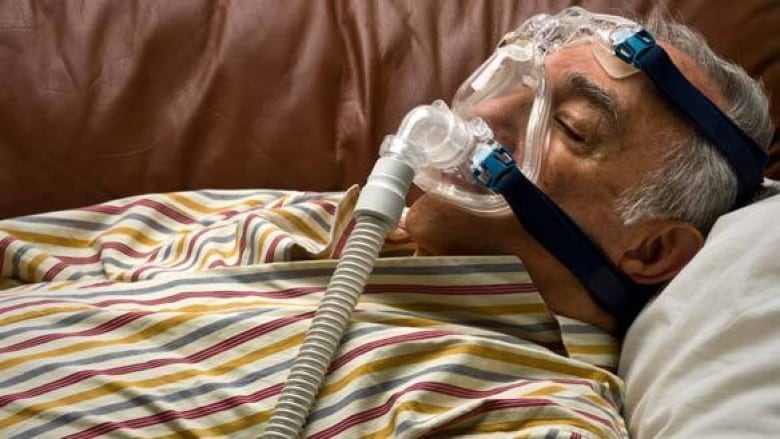Disturbing your sleep patterns

Has your sleeping partner ever woken you up with a sharp jab to the ribs an attempt to get you to tone down snoring that's reverberating throughout your home? Maybe you wake up with a dry mouth and you go through the day not feeling refreshed? Or, perhaps, you fall asleep all right, but have a hard time staying asleep.
You might have sleep apnea.
An estimated 859,000 Canadians or three per cent of the population have been told by a health professional that they have sleep apnea. Many more may not know they have it.
What is sleep apnea?
Sleep apnea refers to pauses in breathing during sleep. Normally, these pauses last between 10 and 30 seconds until the brain reacts to correct the problem. Part of the breathing resumption process involves the sleeper waking up very briefly, but not enough to remember being awake.
The more severe the apnea, the more times sleeper will awake and less refreshed they will feel in the morning.
There are two major types of sleep apnea:
- Obstructive sleep apnea, which occurs when the throat muscles relax. It is the more common form.
- Central sleep apnea, which occurs when your brain and the muscles that control breathing aren't communicating properly.
People with sleep apnea are more likely than the general population to have other chronic conditions, including:
- Diabetes: 2.5 times more likely.
- Hypertension: 1.8 times more likely.
- Heart disease: 2.2 times more likely.
- A mood disorder such as depression, bipolar disorder, mania or dysthymia: 2.2 times more likely.
What causes sleep apnea?

Obstructive sleep apnea occurs when the muscles at the back of your throat relax while you're asleep. Relaxed muscles mean there's no support for the soft palate, uvula, tonsils and tongue. This puts pressure on your airway. It narrows or closes and your breathing briefly stops. Your sleep is interrupted, as you briefly yet frequently wake up.
Central sleep apnea occurs when your brain's signals to your breathing muscles are interrupted. You could wake up with shortness of breath or have difficulty getting or staying asleep. Central sleep apnea is most commonly caused by heart disease or stroke. You are more likely to remember your sleep interruptions with central sleep apnea than you are with obstructive sleep apnea.
What are the risk factors for sleep apnea?
According to the 2009 Canadian Community Health Survey, 26 per cent of Canadian adults had a high risk of having obstructive sleep apnea because of the presence of three or more risk factors or symptoms of the condition, including:
- Snoring loudly enough to be heard through closed doors.
- Often feeling tired, fatigued, or sleepy during the day.
- Having been observed to stop breathing during sleep.
- Having been diagnosed with high blood pressure.
- Having a body mass index (BMI) greater than 35.
- Being over the age of 50.
- Being male.
Other risk factors include:
- A neck circumference of greater than 43 centimetres. A thick neck may narrow your airway.
- A narrowed airway, whether you were born with it or your tonsils or adenoids are enlarged and encroaching on your airway.
- Use of alcohol, sedatives or tranquilizers, which can relax the muscles of your throat, increasing your risk.
- Smoking. Smokers are three times more likely than the general population to develop sleep apnea, possibly because smoking may increase the amount of inflammation and fluid retention in the airway. Quitting helps reduce your risk.
How is sleep apnea treated?
One of the most common treatments for sleep apnea is continuous positive airway pressure (CPAP), in which you wear a mask that's connected to a machine that provides pressurized air to prevent your upper airway from collapsing while you sleep. Keeping the airway open reduces the risk of apnea episodes through the night.
Other treatment options include losing weight, avoiding alcohol and sedatives and oral or dental appliances that help realign the oral cavity again, to help keep your upper airway open while you sleep.
Oral appliances may be easier for some people to tolerate, but they may not be as effective as CPAP.
Another option may be surgery to remove excess tissue from your throat or nose that may be causing you to snore or may be partially blocking your air passages leading to episodes of sleep apnea.
When you sleep on your back, your tongue and palate can rest against the back of your throat and block your airway, leading to sleep apnea. Sleeping on your side or abdomen can relieve that pressure and prevent reduce episodes of snoring, perhaps avoiding that sharp jab from your sleeping partner.












_(720p).jpg)


 OFFICIAL HD MUSIC VIDEO.jpg)
.jpg)



























































































